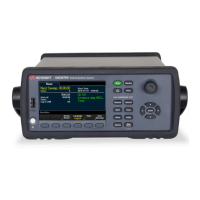TRIGger:SOURce {IMMediate | EXTernal | INTernal | BUS | TIMer | ALARm[{1|2|3|4}]}
TRIGger:SOURce?
Sets the trigger source for measurements.
Parameter Typical return
{IMMediate | EXTernal | INTernal | BUS | TIMer | ALARm[{1|2|3|4}]}
IMMediate = Continuous scan trigger
EXTernal = An external TTL-compatible pulse trigger
INTernal = Trigger when an input signal crosses the specified trigger
level at the specified slope
BUS = Software trigger
TIMer = Internally paced timer trigger
ALARm = Trigger on alarm 1,2,3, and 4
Default: IMMediate
"IMM", "EXT", "INT", "BUS", "TIM", "ALAR1", "ALAR2", "ALAR3", or
"ALAR4".
Selects the external trigger source. In this configuration, the instrument sweeps through the scan list once each time a low-true TTL-com-
patible pulse is received on the rear-panel Ext Trig/Alarms connector.
TRIG:SOUR EXT
INIT
Typical response:EXT
Selects the bus (software) trigger source. Note that the
*TRG
command will not be accepted unless the instrument is in the "wait-for-trig-
ger" state.
TRIG:SOUR BUS
INIT
*TRG
Typical response:BUS
– For the IMMediate (continuous) source, the trigger signal is always present. When you place the instrument in
the "wait-for-trigger" state, the trigger is issued immediately.
– The READ? and MEASure commands and queries cannot be used to take readings when the selected trigger
source is BUS. This is called a trigger deadlock condition.
– For the BUS (software) source, the instrument is triggered by the *TRG command received over the remote inter-
face. The *TRG command will not be accepted unless the instrument is in the "wait-for-trigger" state (INITiate
command). If the instrument receives an external trigger before the next "waiting for trigger" state, it will buffer
one *TRG command and then ignore any additional triggers received (no error is generated).
– For the EXTernal source, the instrument will accept a hardware trigger applied to the rear-panel Ext Trig/Alarms
connector. The instrument takes one sweep through the scan list each time a low-true TTL-compatible pulse is
received. If the instrument receives an external trigger but is not in the "wait-for-trigger" state, it will buffer one
trigger and then ignore any additional triggers received (no error is generated). Also, if the trigger source is BUS,
you can use the [Scan/Start] key as a trigger.
342
Keysight DAQ970A/DAQ973A Programming Guide
2 SCPI Programming

